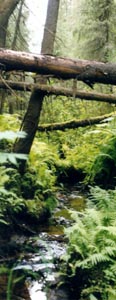
Karelian old-growth mapping
An analysis of the intactness of Karelian forests was conducted jointly by the Biodiversity
Conservation Center and Greenpeace Russia. The generalized result of this analysis
You may see in drawing #1. The more detailed map, as far as the complete list of corresponding
forest blocks (the regular rectangular units, into which all forests under Russian Federal Forestry
Service jurisdiction are divided) has been provided for all interested parties.
The following information sources have been used for this work:
- · The official Federal Forest Service forest maps - of the official forest survey from an
economic point of view conducted periodically in all Russian forests.
- · Remote sensing - space images of high (about 20 meters per pixel) and
medium (about 100 meters per pixel) level resolution.
- · Topographic maps of 1:200,000 scale, and more detailed for some particular sections.
- · Direct on-ground field surveys data by Russian and Finnish non-governmental
and scientific organizations for some particular sections.
Of cause, it is impossible to definitively resolve the question of the real intactness of a
particular forest area without detailed on-site field research. Therefore, relying only on
the above-mentioned source, we realized from the very beginning that the results of our
analysis were merely preliminary. So, we publicly announced the identified sections as
the POTENTIAL OLD-GROWTH FORESTS AREAS. It means, we do not warrantee
that ALL the forests inside are old-growth but there is the high probability to find these
forest here. At the same time, no significant old-growth area should be left outside.
It was quite logically suggested that the on-site field inventory should applied to any
particular section of the potential old-growth to clarify about its real status. Based on the
precautionary principle we demanded the moratorium for any logging in these areas before
the inventory. That means that a final decision about the need for special protection of these
forests can be made only after conducting a thorough field survey of those sections. It's highly
likely that the inventory may discover some parts of these forests are not the old-growth and
may be drawn into economic exploitation.
We tried to construct the criteria for selection so that we would not miss a single forest
tract or section of old-growth forest. However, not-so-large fragments of little-disturbed forests
("not-so-large" in the Karelian context means less than 2000-2500 ha.) which are incapable of
long-term self-maintenance, were consciously excluded from examination. From our point of view,
such fragments should be preserved as key biotops not as specially created protected areas,
but in the process of conducting routine forestry operations. In other words, it's imperative to
change the practice of forestry so that it takes into account the necessity of preserving those
not-so-large "islets" of biodiversity everywhere. Preservation of such fragments of little-disturbed
forests is especially important in southern Karelia, where almost no large plots remain. This is
probably our greatest challenge in the next few years.
In delineating the plots of potential natural old-growth forests, we used three basic criteria:
- · The portion of old (which does not mean old-growth!) forests, older than 120 to 140 years,
within the defined section must cover not less than 50% of the area.
- · The total area of the plot, including other little-disturbed natural territories (undrainaged
marshes, rocky outcroppings, lakes) must be no less than 2000 ha. for central and southern
Karelia (roughly south of the 64th parallel), and no less than 3000 ha. for northern Karelia
(north of the 64th parallel).
- · The plot may also contain some anthropogenically disturbed areas (clearcuts, young
forests, drainage marshes), if it's impossible to draw the border so as to exclude those
territories from the given plot. However, the area of such territories within the plot must
not exceed 20%.
Besides the three basic criteria, a number of supplementary criteria were used, such
as the absence of a road network within the plot (with the exception in some cases of
old roads); the percentage of deciduous tree species; and others.

The total area of the potential old-growth forests defined by our analysis is around
10% of the Karelian forests. However, we do not think this problem can not be solved
on the Karelian scale. So, only 60% of the Karelian allowable cutting level is being
harvested annually, it is possible to move cuttings from old-growth areas to less valuable
secondary forests. In addition, a significant portion of old-growth forests is located on remote
areas that makes the harvesting there unprofitable. It's also essential to keep in mind that
the delineated plots are still only potential. As a result of field surveys, the area of
delineated old-growth forests may decrease sufficiently.
At the same time, for some particular Karelian districts where the percentage of
earmarked plots is significant that creates serious problems for local economy. The
last year has showed, however, the possibility to solve the problem with all interested
parties involved. For example, the negotiation process between NGOs, loggers and local
authorities in the Kostomuksha district in northern Karelia had resulted in joint field inventory.
Large areas have been surveyed in the summer 1997. The difficult and compromising
process is not finished yet. However, it is rather clear today for all parties involved that
conservation efforts may anyway leave enough room for sustainable economic activity.
Back to Old-growth page
|





